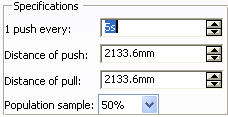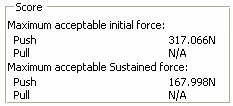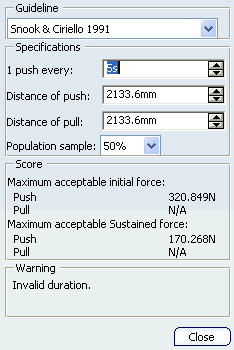| Guideline |

From this list, select the guideline to perform the analysis. In
this analysis, only one guideline is available.
|
| Specifications |

- 1 push every:
Use this field to determine the push frequency. Select the arrows
to increase or decrease the value indicated in the text field or
directly enter a new value using the keyboard.
- Distance of push:
Use this field to specify the distance of the push. Select the
arrows to increase or decrease the value indicated in the text
field or directly enter a new value using the keyboard.
- Distance of pull:
Use this field to specify the distance of the pull. Select the
arrows to increase or decrease the value indicated in the text
field or directly enter a new value using the keyboard.
- Population sample:
Three population percentiles are provided: 90th, 75th, and 50th.
These percentiles represent the percentage of the population able
to perform the task safely. The selected percentile takes the
manikin gender into account.
|
| Score |
Immediately after the Specification fields are completed, the
results are displayed in the Score zone.

The initial forces are required to initiate the object's motion.
As the object begins to move, these forces start to decline to a
relatively constant level (sustained forces).
- Maximum acceptable initial force:
This value expresses the force required to put an object into
motion.
- Maximum acceptable sustained force:
This value expresses the force required to keep the object in
motion.
|
| Warning |

Immediately after the Specification fields are completed, the
results are displayed in the Warning zone.
|
| Report |
See Reporting Capabilities - Updating |




